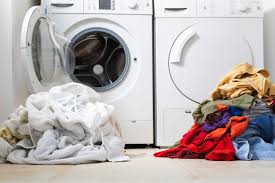Laundry is a fact of life, and in addition to your effort, it requires resources to get all those clothes clean and dry. I was reading an article on consumerreports.org about this and it states that in electricity alone—to say nothing of water—Americans used 10 billion kilowatt-hours washing laundry at home last year, and 60 billion kilowatt-hours drying it.
In the article it state that around 10 percent of a home’s total electricity use goes to washing and drying clothes. Here are some tips on laundry that can impact and reduce the amount of energy that is used to do laundry in our homes.
In the Washing Machine
1. Choose an eco-friendly Green Choice washer. Marked by a green leaf icon in our ratings, Green Choice distinguishes the most eco-friendly washers from the rest in CR’s ratings. Aside from washing performance, these models use less water and less energy, and they are more likely to require fewer repairs.
2. Opt for cold water when you can. Tests have found that laundry detergents have gotten much better at putting enzymes to work in removing dirt and stains at lower water temperatures. Brighten whites with cold water and a bleach alternative, such as OxiClean. You’ll need hot water, however, for tackling oily stains, cleaning dirty diapers, or washing sheets and towels when a family member is sick.
3. Use high-efficiency (HE) detergent for front-loaders, high-efficiency top-loaders, and where otherwise recommended by the washer’s manufacturer. Water-efficient washers work best with these low-sudsing detergents. Regular detergent produces too many suds for these machines and can cause the washer to repeatedly rinse laundry, wasting water and time.
4. Increase the spin speed. This extracts more water from your laundry, cutting dryer time. If you’ve tried this and found that clothes come out wrinkled after drying, remove the laundry from the washer, untangle, and shake out before you toss into the dryer.
5. Avoid the sanitary cycle, except when truly necessary. It relies on an internal heater to boost the water’s temperature, and it increases energy use significantly, according to Energy Star.
In the Dryer
6. Clean the lint screen and dryer duct. Clean the lint screen before every load to improve air circulation and prevent fires. And if you use dryer sheets, know that they can leave a film on the filter that reduces airflow. So once a month, scrub the filter with a brush. Also, clean the dryer duct regularly to keep the air moving. This helps dry your laundry faster and helps prevent fires.
7. Clean the moisture sensors. Dryer sheets can leave residue on the sensors as well, which can build up and trick the machine into thinking laundry is dry. Your owner’s manual will offer advice on cleaning the sensors.
8. Dry similar items together. And don’t mix heavy cottons with lightweight fabrics. Dry (as well as wash) towels with towels and sheets with sheets.
9. Use the automatic cycle instead of timed drying. For most dryers, the auto cycle relies on one or more moisture sensors to determine when laundry is dry to avoid overdrying.
10. Try line-drying. Go solar on your drying and put in a clothes line if you have the outdoor space!
